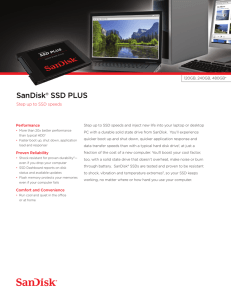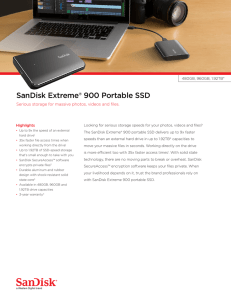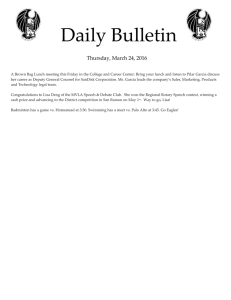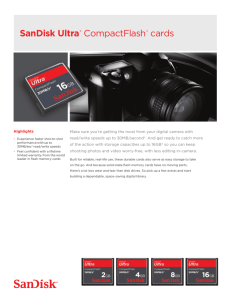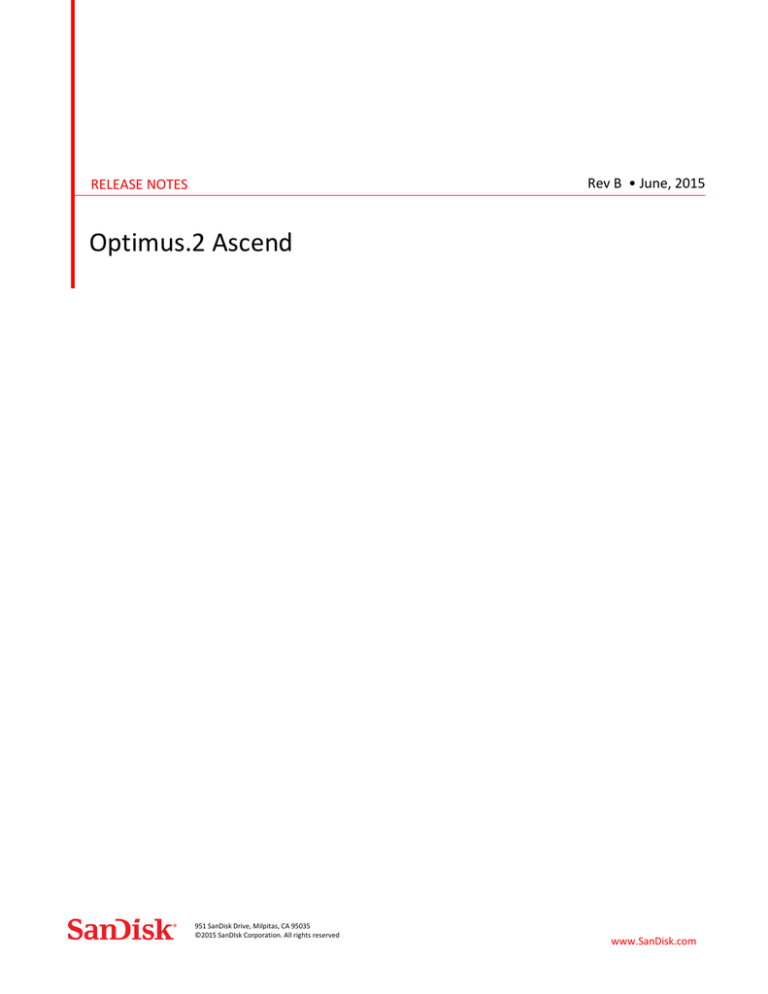
Rev B • June, 2015
RELEASE NOTES
Optimus.2 Ascend
951 SanDisk Drive, Milpitas, CA 95035
©2015 SanDIsk Corporation. All rights reserved
www.SanDisk.com
Optimus.2 Ascend Release Notes | Rev B
ESD Caution – Handling
Static electricity may be discharged through this disk subsystem. In extreme cases, this may temporarily interrupt the operation or damage components.
To prevent this, make sure you are working in an ESD-safe environment. For example, before handling the disk subsystem, touch a grounded device, such
as a computer case.
Disclaimer
The SanDisk Corporation general policy does not recommend the use of its products in life support applications wherein a failure or malfunction of the
product may directly threaten life or injury. Without limitation to the foregoing, SanDisk shall not be liable for any loss, injury, or damage
caused by use of its products in any of the following applications:
•
Special applications such as military related equipment, nuclear reactor control, and aerospace.
•
Control devices for automotive vehicles, train, ship and traffic equipment.
•
Safety systems for disaster prevention and crime prevention.
•
Medical‐related equipment (including medical measurement devices).
Accordingly, in any use of SanDisk products in life support systems or other applications where failure could cause damage, injury or loss of life, the
products should only be incorporated in systems designed with appropriate redundancy, fault tolerant or back‐up features. Per SanDisk Terms and
Conditions of Sale, the user of SanDisk products in life support or other such applications assumes all risk of such use and agrees to indemnify, defend, and
hold harmless SanDisk Corporation and its affiliates against all damages.
Security safeguards, by their nature, are capable of circumvention. SanDisk cannot, and does not, guarantee that data will not be accessed by
unauthorized persons, and SanDisk disclaims any warranties to that effect to the fullest extent permitted by law.
This document and related material is for information use only and is subject to change without prior notice. SanDisk Corporation assumes no
responsibility for any errors that may appear in this document or related material, nor for any damages or claims resulting from the furnishing,
performance or use of this document or related material. Absent a written agreement signed by SanDisk Corporation or its authorized representative to
the contrary, SanDisk Corporation explicitly disclaims any express and implied warranties and indemnities of any kind that may or could be associated with
this document and related material, and any user of this document or related material agrees to such disclaimer as a precondition to receipt and usage
hereof. EACH USER OF THIS DOCUMENT EXPRESSLY WAIVES ALL GUARANTIES AND WARRANTIES OF ANY KIND ASSOCIATED WITH THIS DOCUMENT
AND/OR RELATED MATERIALS. WHETHER EXPRESSED OR IMPLIED, INCLUDING WITHOUT LIMITATION, ANY IMPLEIED WARRANTY OF MERCHANTABILITY
OR FITNESS FOR A PARTICULAR PURPOSE OR INFRINGEMENT, TOGETHER WITH ANY LIABILITY OF SANDISK CORPORATION AND ITS AFFILIATES
UNDER ANY CONTROL, NEGLIGENCE, STRICT LIABILITY OF SANDISK CORPORATION AND ITS AFFILIATES UNDER ANY CONTRACT, PROFIT OR OTHER
INCIDENTAL, PUNITIVE, INDIRECT, SPECIAL OR CONSEQUENTIAL DAMAGES, INCLUDING WITHOUT LIMITATION PHYSICAL INJURY OR DEATH, PROPERTY
DAMAGE, LOST DATA, OR COSTS OF PROCUREMENT OF SUBSTITUTE GOODS, TECHNOLOGY OR SERVICES.
No part of this document may be reproduced, transmitted, transcribed, stored in a retrievable manner or translated into any language or computer
language, in any form or by any means, electronic, mechanical, magnetic, optical, chemical, manual or otherwise, without the prior written consent of
an officer of SanDisk Corporation.
All parts of the SanDisk documentation are protected by copyright law and all rights are reserved. SanDisk and the SanDisk logo are registered trademarks
of SanDisk Corporation, registered in the United Sates and other countries. Other brand names mentioned herein are for identification purposes
only and may be the trademarks of their respective holder(s). Copyright 2015 SanDisk Corporation. All rights reserved.
SanDisk, Inc.
951 SanDisk Dr.
Milpitas, CA 95035
www.sandisk.com
An ISO 9001 certified company.
Optimus.2 Ascend Release Notes | Rev B
Revision History
Date
Revision
Description
June 2015
B
F760
August 2014
A
F6C2
April 2014
1
F670 Initial Release
Optimus.2 Ascend Release Notes | Rev B
Overview
This document describes the fixes and known issues for the Optimus.2 Ascend firmware.
F760 Firmware
The F760 firmware contains the following fixes:
Implemented a fix for an issue that was causing a command timeout event.
Fixed an issue where low OP drives have incorrect database maximums.
Added a safeguard against a memory allocation failure to prevent drives from hanging.
Changed the default global SCRAM timeout from 5 milliseconds to 6 milliseconds.
Added a persistent non-volatile counter to track single-bit ECC corrections.
Enabled write limiter by default to reduce write fragmentation that improves write performance at high QD and
xfer-size.
Added changes to disable rate matching support and increase queue depth support to 252.
Fixed Logical Block Reference Tag error being falsely reported on 32 byte read command.
Modified port behavior so that after the new firmware is written to the SPI and before the new firmware gets
activated, the port sends out BUSY to all requests from the initiator. We can now safely come back up with the
new firmware and continue as normal.
Fixed an issue with sense data errors in Send diagnostic command.
Fixed an issue to check the ParameterListLength field in the Unmap CDB.
Changed Persistent Reservation Out command to correctly ignore non 0 Scope values for Service Actions, Register,
Register and Ignore, and Clear.
Fixed an issue where a response to a read command issued to flash was not being handled correctly while
Servicing a verify operation.
Changed Persistent Reservation Out command to check Allocation Length and return
kPARAMETER_LIST_LENGTH_ERROR if it is !=24 bytes.
Ensured that overlap_chain is always flagged as invalid on all commands, even immediately after reboot when a
slot is being used by a read.
Avoided faulty ACK/NAK Time Out (ANTO) on certain retries exhausted cases.
Avoided early ReadQueue transmits from accessing unexpected DDR location causing single and double bit DDR
errors.
Resolved an issue where by recovering from a failed read, we read the data from DDR but don't take into account
the allocation unit of the recovery.
Fixed rate matching logic so that it will restore the Link state for normal operations when a RETRY EXHAUSTED (or
CONNECTION DENIED with no extended status) event happens. This will keep the drive from going unresponsive.
Moved process_unmap_region back into fast RAM to restore its performance.
Optimus.2 Ascend Release Notes | Rev B
Added safeguard against memory allocation failure to prevent drives from hanging.
Fixed an issues where not removing tags after errors caused overlapped commands.
Fixed and issue for SCRAM margining on software reset and code downloads.
Fixed an issue for Persistent Reservation Out issues seen in Microsoft "SCSI-3 Persistent Reservation requirements
test" and "Validate Storage Spaces Persistent Reservations test". Added code additions to the handling of "Register
and Ignore" and "Preempt".
Fixed an issue that caused HEAD OF QUEUE commands to block other SIMPLE commands.
Added a check to ensure a correct response when a parameter list length resulted in truncation.
Implemented a WriteLimiter functionality which prevents Write commands from starting if there is too much write
data already in flight.
Fixed an issue where an Ack/Nak timeout on a read could cause IT Nexus loss instead of reporting Aborted
Command.
Shortened the host data transfer lengths for 4Kb+ block size in socal_regression_pi2.py that can cause Windows to
blue-screen.
Repaired an inadvertent change to the TOKENIZED_PRINT that generates the FLASH_EXERCISER_ROW entry in the
common diagnostic output.
Addeded a compile time assert to check whether MAX_DEFECTS_IN_DB can actually guarantee a certain
percent of erase blocks.
Increased the threshold for doing 100% recycles.
Increased the CUTOFF_AGE_OF_PENDING_LOGICAL_PAGE to take into account the size of the logical pages.
Increased the precondition of power cycle tests to prevent event injection failure.
Added supported builds to Makefile and improved layout of help.
Enabled support for Rate matching. Fixed ITNL and IRTOs in multi-initiator environment with mixed read and write
traffic.
Fixed an issue found in multi-initiator TMF testing.
Added a feature which will allow events in the event log to consume less space, which will allow for more events to
be stored in the log.
Added support for temperature throttling on PCB-based NAND sensors.
Set the subpage write caching feature to enable by default.
Resolved an issue related to stranded bytes in the hardware FIFO that could result in an 03/0C/00/06 sense key.
Disabled the scram margining feature which caused the erasing of the area after each code load.
Reduced code load time.
Fixed an issue with the SMART min/max data being unnecessarily saved after every power cycle. It should be saved
only when one of the min or max values change.
Changed the SDF ID of the saved write amplificaiton min/max values so that any previous (and false) values will be
forgotten.
Optimus.2 Ascend Release Notes | Rev B
Fixed an issue where Read Buffer mode 0 was returning an incorrect status.
Resolved an issue with the SPI flash where a sector was stuck in a state that appeared to be erased, but writing to
that sector caused program errors. This would happen if the drive lost power while that flash section was being
erased.
Fixed an issue where the Read and Verify counters were getting modified due to false unrecovered errors
introduced by Write Long command.
Made modifications that provide steadier performance at low queue depths.
Made changes so that the drive checks for data alignment for the Write Buffer command.
Added support to notify CPU0 of recycle failure.
Added support for a SMART trip in the event of a SPI flash write failure.
Fixed an issue to protect the SCSI format against power failures.
Fixed an issue of CPU0 data aborts in the event log handler when 15 parameters are used.
Fixed an issue to give INITIATOR RESPONSE TIMEOUT priority over IT NEXUS LUN TIMEOUT when they are set the
same.
Added updates for high queue depth and PI Stripping.
Avoided false PI Stripping detection and could lead to false ITNL and bad link behavior.
Issues still unresolved
Drive failed during SRT Powercycle.
Drive hit a mismatched Valid Page Count for Closed SB failure during FlashManagement-FI_WriteInterrupt Test.
Drive failed with ERROR_DATA_OVER_UNDER_FLOW during TMF multi initiator tests using Oak Gate.
Drive failed with a IO Hung Error during IO Multi-Initiator tests using Oak Gate.
Drive became inactive or offline during Cable Pull signal only.
When formatting with Type 2 PI, under rare conditions the drives may cause a command timeout on reads.
F6C2 Firmware
The F6C2 firmware contains the following fixes:
Fixed an issue with Send Diag Selftest that caused various data errors on verify, read, and write verify commands
while running command loop tests.
Improved performance boose when reading and verifying unmapped LBAs.
Fixed an issue in the format path that was causing LBA counts to be truncated.
Fixed an issue in the detection of reserve byte/bit violations in performance commands.
Fixed an issue so that the drive does not return a Reservation conflict if the Standard Reservation holder issues a
second Reserve command.
Fixed an issue where the drive would return an unexpected 0B/44/00/03 DELIVERY_TIME_LIMIT_EXCEEDED after
having run large IOs on commands that may take longer than 100ms.
Fixed an issue that caused the drive to return invalid 05/24/00 errors under mixed workloads using 10 and 16 byte
commands.
Removed un-needed 5 sec delay from Send Diag Short selftest.
Optimus.2 Ascend Release Notes | Rev B
Fixed an issue with the handling of skipwrites and overlap detection.
Added 48-bit LBA support to overwrite.
Fixed an issue with Write Buffer command for a transferlength of 0.
Improved write bandwidth at 16K to 32K transfer sizes by increasing AXR allocation from 8K to 16K and by
disabling AXR on xfers larger than 16K.
Added support for an RSA signature on firmware images.
Fixed an issue thatwas causing Write Same to fail.
Added support for 4096 + PI2 sector size.
Made performance enhancements to WriteSame in uninitialized/unmapped pages.
Modified the code to reject a Write Buffer command if the allocation length is larger than the Write Buffer Max
Download Size.
Changed percent drive life used SMART trip threshold from 0% to 2%.
Added support for parameter 5 in the Verify Error Counter log page (05h).
Fixed an issue when a drive temperature goes over the threshold it wil report the warning or trip immediately
instead of delaying it by up to 15 minutes.
Fixed an issue where Linux mounted Optimus ECO resulted in an aborted command during read/write.
Added support for the Exit Failure Mode and Overwrite service actions in the Sanitize command.
Added an event log for changing the SMART sense code.
Added support for the PBLOCK bit in the Read Long and Write Long commands.
Disabled SCSI Protection Information so that formatting the drive with PI enabled is illegal. When the drive is
formatted with PI disabled the customer will not see the problem that can occur when PI is being stripped during a
Read command. If the drive remains formatted with PI enabled after loading this code, its behavior will not be
changed except to make formatting with PI enabled illegal.
Fixed an issue where the Interrupted SANITIZE operations will start again after a power cycle.

